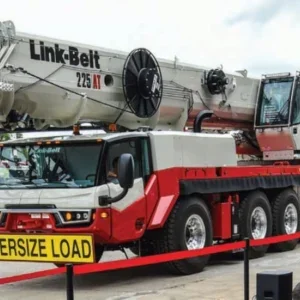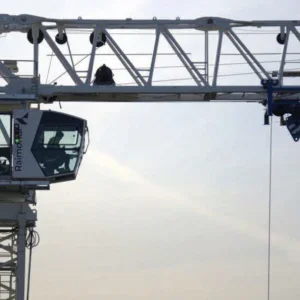TII’s Scheuerle has a long history of innovation. At the handover event for its new STB550, the company had one of the first batch of SPMTs it had ever sold.
TII Sales Bernd Schwengsbier is president of TII Sales, the sales and marketing arm of Scheuerle parent company TII. He says, "We have had our standard SPMT for 30 years, which has been a success. We recently got our first SPMT back from the client after 30 years, who has had it in continuous operation."
The handover gave Scheuerle an opportunity to show off some more recent innovations. The star of the show was the new STB550 bridge girder, designed to transport giant transformers and generators.
At the launch, Schwengsbier said, "We are delighted to present a ready for operation side girder deck with a ratio of 5.2 between payload and deadweight. If we omit the load distribution frame, as is common within the marketplace when calculating this figure, the factor becomes a currently unrivalled 6.6. At the same time, the STB 550 is much more versatile than comparable products on the market and thus guarantees Collett a headstart within the industry."
A key part of the bridge girder’s flexibility is its modular design. Schwengsbier says, "What we provide to clients like Collett is flexibility, that all types of transformers can be transported with these decks. That’s the reason we have so many intermediate pieces, so many couplings and so on. That makes the system very flexible for the client. We have transformers with high, intermediate, and lower take-off, with front coupling takeoff, we have generators and so on, and all of these can be transported with this equipment."
Lincoln Collett, technical director for Collett Transport, took delivery of the STB550, driving it out of the Scheurle factory. He said, "The new side girder deck closes the last gap in our fleet. The cooperation between Collett and Scheuerle has worked excellently and we are extremely satisfied with the outcome."
Wider innovation
The event gave TII to show off many of its other innovations. Many of these involved building on its 30-year-old record in SPMT manufacturing.
Innovation is key for a company like TII. Schwengsbier says, "The group has seen continuous growth over the last years. It’s good to see how the market is accepting the high technology of the trailers, and how our clients are using SPMTs for different applications, allowing us to have big growth every year.
We answer to our clients, with our engineering teams, to their needs. We give clients our technical expertise, and they give us their needs in the market. "
The company has recently developed a split SPMT, the SPMT SL. This can be split longitudally, so SPMTs be arranged in threefile platforms. The next step has been to develop a widening system for the split SPMTs, powered by the platform’s built in power pack unit.
Schwengsbier says, "We have different technologies for widening SPMTs. We have scissor type systems, which are in production now. We’ve developed a telescopic beam solution, where we add on bars. Both allow widening of split SPMT systems. These are good for shipyards or where else you operate modules. It allows you to operate side-by-side in a cheap way."
In a shipyard, where ship blocks under construction may only weigh a few tens of tonnes, but are the size of a small building and have a high centre of gravity, the split system improves the balance of the SPMT platform, without the need to use more modules than are required to carry the load.
Scheuerle is also working to develop the capacity of its SPMTs. Again, this is inspired by the specific needs of a particular sector.
Schwengsbier says, "We are going to increase payload capacity. Development of SPMTs starts at 28t/32t capacity per axle. Now we will be going up to 36t, 40t, 48t and even up to 60t. These are all on standard SPMTs, but designed for special applications: 90% of the market can’t operate with these capacities as jetties and barges can’t take axle loads over 32t. But for some niche markets, you need higher axle loads."
As well as getting stronger, Scheuerle has developed SPMT’s that are more rigid. Schwengsbier says, "We’ve developed high beam SPMTs. At the moment, a standard SPMT has a bending moment of +/- 7280kN. With the new high beams we can go up to a bending moment of +/-9250kN, 15% higher than standard."
Scheuerle is also developing faster SPMTs. This might sound like a bit of an odd enterprise, as we generally picture SPMTs being used to move modules on and off barges or to assemble blocks at a shipyard.
But some applications, such as moving large modules for remote oil and gas installations in Australia, SPMTs can be used for journeys taking days. Here, a few miles per hour more speed might translate into a day’s travel saved.
Schwengsbier says, "Right now we are working on higher speed solutions, as transport distances in oil and gas are getting bigger and longer. We’re looking at ways to make logistics faster for the client. Faster means cheaper, time is money."






